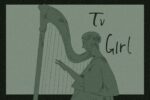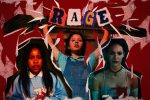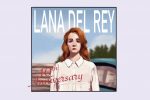Attention, witches: Lana Del Rey’s highly-anticipated, explicitly-titled new album, “Norman F—ing Rockwell!” is here, and it is everything. Following her 2017 album, “Lust for Life,” “NFR” (as Del Rey herself has been calling it in interviews) finds the artist in a completely new frame of mind.
If “Lust for Life” was her most joyous album (it’s her only album that shows her smiling on the cover art), “NFR” is her most uncertain and inquisitive. She questions where this happiness is rooted, if it’s even real and, ultimately, what in the world around her prevents her from finding this happiness. Below, I will break down the album’s highlights, as well as my personal favorites, and figure out what, exactly, all this California dreaming is about.
1. “Norman f—ing Rockwell”
The titular and opening track, “Norman f—ing Rockwell,” is my favorite song on the entire album. Somehow, Del Rey manages to avoid any mention of Norman Rockwell in it at all. Rockwell was an American author and artist, most famous for his cover illustrations for The Saturday Evening Post. He created many pieces depicting everyday American life, such as “Freedom from Want,” “The Problem We All Live With” and “Triple Self-Portrait.”
It is clear that throughout this album, Del Rey is attempting to use the same general aesthetic and themes as Rockwell, made evident by the transitional cover art that turns into a painting toward the top, as well as the way she describes the simple things she does every day, romanticizing everything from LA culture to bartenders.
In this song, however, the singer reminds us what this album is really about. The melody is extremely light and happy, while the lyrics are tragically sad. She calls her lover — this poetic, god-like figure — a “man-child” who treats her poorly, but whom she cannot escape. We are allowed to peek behind the façade she has built up, to see that, just because something looks idealized, does not necessarily mean it is ideal. “Norman f—ing Rockwell” is a perfect introduction to the album.
2. “Venice B—ch”
Clocking in at 9 minutes, 37 seconds, “Venice B—ch” is the longest song on the album. It is also the first (and only) time we hear the words “Norman Rockwell.” The beauty of both of these facts is that they make “Venice B—ch” the connective tissue of the album. Venice is mentioned earlier in the album on the song “Mariners Apartment Complex,” another tie that connects this song to others on the album and truly shows how conceptual and cohesive “NFR” is.
“Venice B—ch” pulls all the pieces together with its detail, storytelling and wording, so that listeners feel like they are hearing a complete work of art rather than a random assortment of unrelated songs. Though some might call its length a fault, I think it’s one of its strengths; “Venice B—ch” is meant to be a long ballad, the kind that is performed live. It’s a fun nod to Del Rey’s previous songs and the artists who influenced her, like Janis Joplin, who were famous for their extremely long songs that became sort of a spiritual experience for audiences at festivals like Woodstock. Plus, the synths that come in during the instrumentals create this weird, intoxicating atmosphere that you just can’t help but love.
3. “Doin’ Time”
“Doin’ Time,” a cover of the 1997 song by Long Beach ska-punk group Sublime, was not originally supposed to be on “NFR.” It was released earlier this year as a single, in conjunction with a documentary about Sublime from Interscope Films, a division of Universal Music Group, which owns both Sublime and Lana Del Rey’s catalogs. However, Del Rey liked her recording so much and thought it went so well with the album that she asked if it could be added in last-minute, which Universal happily approved.
And thank God they did, because “Doin’ Time” is an absolute treasure. It glorifies the summertime California aesthetic and laments untrue partners, just like the rest of “NFR” does, and it even adds a transcendental flutter of vocals as Del Rey sings, “Evil, I’ve come to tell you that she’s evil, most definitely,” toward the end. It’s strange to hear Del Rey sing these words but, ultimately, it makes perfect sense.
The music video is a cinematic, visual experience of female solidarity that plays out the other side of this double standard, portraying a gigantic woman that comes out of a movie screen to take revenge on a cheating man on behalf of his girlfriend, further asking us to question the world around us.
4. “Cinnamon Girl”
This song seriously takes me back to “Born to Die,” for some reason — it gives me such a strong vibe of Del Rey’s older music. When she sings about what it’s like to love someone struggling with addiction, her voice sounds like it did in “Video Games.” It’s absolutely heart-wrenching.
Written with visionary Jack Antonoff (who co-wrote much of the rest of the album, as well), “Cinnamon Girl” finds itself in the category of the introspective, love-lost pop song, and, like Antonoff’s works with similar songs (such as Lorde’s “Liability”), “Cinnamon Girl” is stripped down, for the most part; compared to many other songs on “NFR,” there is very little post-production. It’s almost completely sparse instruments and vocals, aside from the subtle reverb of the same synth sound that appears on “Venice B—ch.”
Antonoff has become well-known for his production in recent years, but when he takes all that out and lets the lyrics really speak for themselves, it’s extra powerful. Paired with Del Rey’s fantastic voice and ghostly poetry, you get one of the most intense, beautiful songs ever: You get “Cinnamon Girl.”
5. “The greatest”
“The greatest” is definitely the most questioning of all the tracks on “NFR.” It describes the failings of her dreamy West Coast imaginings, saying, “Those nights were on fire, we couldn’t get higher,” before flipping to “But nobody warns you before the fall.” Here, we are finally told outright that, even though “the culture is lit,” the world is not as it seems.
Del Rey gets political, too, remarking, “LA is in flames, it’s getting hot,” a clear commentary on recent wildfires and the rising severity of climate change, and she complains, “Kanye West is blond and gone,” referencing West’s fall from public grace, especially among African Americans, following the revelation that he supports Donald Trump, among other things. This is Del Rey’s way of saying that just because someone or something looks perfect doesn’t mean that they are, which certainly fits the narrative of her album cycles.
Finally, “The greatest” concludes with the lines, “‘Life on Mars’ ain’t just a song. I hope the live stream’s almost on,” proving once and for all that we are, indeed, living in a simulation. You heard it here first, folks.
6. “hope is a dangerous thing for a woman like me to have – but I have it”
The last song on “NFR,” “hope is a dangerous thing for a woman like me to have – but I have it,” fully encompasses what this album is. The mixture of girl power (with references to Sylvia Plath), the downward-facing tone and the ever-present mood that makes you wonder, “Is this even real?” come together in this final anthem to create something amazing. Just as she has throughout the rest of the album (and in real life), the New York native sings about how “They write that [she’s] happy, they know that [she’s] not,” speaking on the general reaction she received after her last album, “Lust for Life.”
One lyric in particular has brought a lot of controversy for the singer: “Shaking my a— is the only thing that’s got this black narcissist off my back,” with debates stirring over whether the line is “black narcissus,” a reference to the flower that has historically been used to describe general bad feelings, or if it actually is “black narcissist,” which has possible racist undertones and could be in reference to her short-lived feud with rapper Azealia Banks.
https://twitter.com/LanaDelRey/status/1049791262453260288?s=20
However, I think that is the point of the song; Del Rey wants us to question the intentions and personas of our favorite celebrities. She wants us to see that none of it is really real, and we are meant to question other people’s fake happiness —and even our own.
That is what “NFR” is all about, and if this sounds sad to you, you would be right. It is sad. However, there is one little spark of hope and, as the title would suggest, hope is what really matters here. It’s what drives us out of the spiral of fake happiness, because even if everything isn’t as okay with Del Rey as we thought it was a few years ago, she sees a future in which it could be okay. She has hope, among all her questioning. Even if it’s dangerous for a woman like her to have hope, she has it.
















